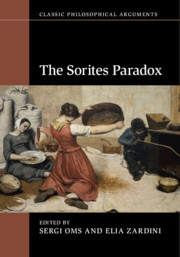Book contents
- Frontmatter
- Contents
- List of Contributors
- Acknowledgements
- Prelude
- Part I Solutions to the Sorites Paradox
- 1 Epistemicism and the Sorites Paradox
- 2 Supervaluationism, Subvaluationism and the Sorites Paradox
- 3 Contextualism and the Sorites Paradox
- 4 Incoherentism and the Sorites Paradox
- 5 Intuitionism and the Sorites Paradox
- 6 Rejection of Excluded Middle and the Sorites Paradox
- 7 Dialetheism and the Sorites Paradox
- 8 Degree Theory and the Sorites Paradox
- 9 Non-Transitivism and the Sorites Paradox
- Part II The Influence of the Sorites Paradox
- Coda
- References
- Index
7 - Dialetheism and the Sorites Paradox
from Part I - Solutions to the Sorites Paradox
Published online by Cambridge University Press: 20 September 2019
- Frontmatter
- Contents
- List of Contributors
- Acknowledgements
- Prelude
- Part I Solutions to the Sorites Paradox
- 1 Epistemicism and the Sorites Paradox
- 2 Supervaluationism, Subvaluationism and the Sorites Paradox
- 3 Contextualism and the Sorites Paradox
- 4 Incoherentism and the Sorites Paradox
- 5 Intuitionism and the Sorites Paradox
- 6 Rejection of Excluded Middle and the Sorites Paradox
- 7 Dialetheism and the Sorites Paradox
- 8 Degree Theory and the Sorites Paradox
- 9 Non-Transitivism and the Sorites Paradox
- Part II The Influence of the Sorites Paradox
- Coda
- References
- Index
Summary
The chapter explains and defends a dialetheic account of vagueness and its solution to the Sorites Paradox. According to this, statements in the middle of a Sorites progression are both true and false. After an explanation of an appropriate paraconsistent logic, detailed models of Sorites transitions are provided. Crucial to any supposed solution to the Sorites Paradox is how it handles the matter of cut-offs. Much of the chapter concerns how a dialetheic solution handles this.
- Type
- Chapter
- Information
- The Sorites Paradox , pp. 135 - 150Publisher: Cambridge University PressPrint publication year: 2019
- 2
- Cited by

